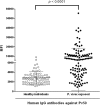Identification and characterization of Pv50, a novel Plasmodium vivax merozoite surface protein
- PMID: 30999945
- PMCID: PMC6474066
- DOI: 10.1186/s13071-019-3434-7
Identification and characterization of Pv50, a novel Plasmodium vivax merozoite surface protein
Abstract
Background: Plasmodium vivax contains approximately 5400 coding genes, more than 40% of which code for hypothetical proteins that have not been functionally characterized. In a previous preliminary screening using pooled serum samples, numerous hypothetical proteins were selected from among those that were highly transcribed in the schizont-stage of parasites, and highly antigenic P. vivax candidates including hypothetical proteins were identified. However, their immunological and functional activities in P. vivax remain unclear. From these candidates, we investigated a P. vivax 50-kDa protein (Pv50, PVX_087140) containing a highly conserved signal peptide that shows high transcription levels in blood-stage parasites.
Results: Recombinant Pv50 was expressed in a cell-free expression system and used for IgG prevalence analysis of patients with vivax malaria and healthy individuals. Immune responses were analyzed in immunized mice and mouse antibodies were used to detect the subcellular localization of the protein in blood-stage parasites by immunofluorescence assay. A protein array method was used to evaluate protein-protein interactions to predict protein functional activities during the invasion of parasites into erythrocytes. Recombinant Pv50 showed IgG prevalence in patient samples with a sensitivity of 42.9% and specificity of 93.8% compared to that in healthy individuals. The non-cytophilic antibodies IgG1 and IgG3 were the major components involved in the antibody response in Pv50-immunized mice. Pv50 localized on the surface of merozoites and a specific interaction between Pv50 and PvMSP1 was detected, suggesting that Pv50-PvMSP1 forms a heterodimeric complex in P. vivax.
Conclusions: Increased immune responses caused by native P. vivax parasites were detected, confirming its immunogenic effects. This study provides a method for detecting new malaria antigens, and Pv50 may be a vivax malaria vaccine candidate with PvMSP1.
Keywords: Antigenicity; Immunogenicity; Merozoite surface protein; Plasmodium vivax; Protein interaction; Pv50.
Conflict of interest statement
The authors declare that they have no competing interests.
Figures







Similar articles
-
Characterization of Pv92, a Novel Merozoite Surface Protein of Plasmodium vivax.Korean J Parasitol. 2016 Aug;54(4):385-91. doi: 10.3347/kjp.2016.54.4.385. Epub 2016 Aug 31. Korean J Parasitol. 2016. PMID: 27658588 Free PMC article.
-
Characterization of a novel merozoite surface protein of Plasmodium vivax, Pv41.Acta Trop. 2013 Jun;126(3):222-8. doi: 10.1016/j.actatropica.2013.03.002. Epub 2013 Mar 13. Acta Trop. 2013. PMID: 23499861
-
Antigenicity and immunogenicity of PvRALP1, a novel Plasmodium vivax rhoptry neck protein.Malar J. 2015 Apr 29;14:186. doi: 10.1186/s12936-015-0698-z. Malar J. 2015. PMID: 25925592 Free PMC article.
-
N-terminal Plasmodium vivax merozoite surface protein-1, a potential subunit for malaria vivax vaccine.Clin Dev Immunol. 2013;2013:965841. doi: 10.1155/2013/965841. Epub 2013 Sep 28. Clin Dev Immunol. 2013. PMID: 24187566 Free PMC article. Review.
-
Plasmodium vivax Reticulocyte Binding Proteins for invasion into reticulocytes.Cell Microbiol. 2020 Jan;22(1):e13110. doi: 10.1111/cmi.13110. Epub 2019 Sep 8. Cell Microbiol. 2020. PMID: 31469946 Free PMC article. Review.
Cited by
-
Plasmodium vivax vaccine: What is the best way to go?Front Immunol. 2023 Jan 16;13:910236. doi: 10.3389/fimmu.2022.910236. eCollection 2022. Front Immunol. 2023. PMID: 36726991 Free PMC article. Review.
-
Plasmodium vivax serological exposure markers: PvMSP1-42-induced humoral and memory B-cell response generates long-lived antibodies.PLoS Pathog. 2024 Jun 28;20(6):e1012334. doi: 10.1371/journal.ppat.1012334. eCollection 2024 Jun. PLoS Pathog. 2024. PMID: 38941356 Free PMC article.
References
-
- WHO . World malaria report 2018. Geneva: World Health Organization; 2018.
MeSH terms
Substances
Grants and funding
LinkOut - more resources
Full Text Sources
Molecular Biology Databases

